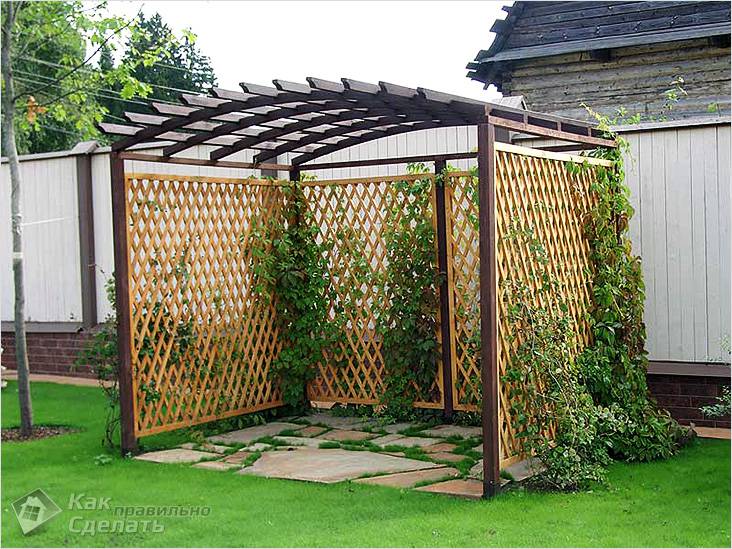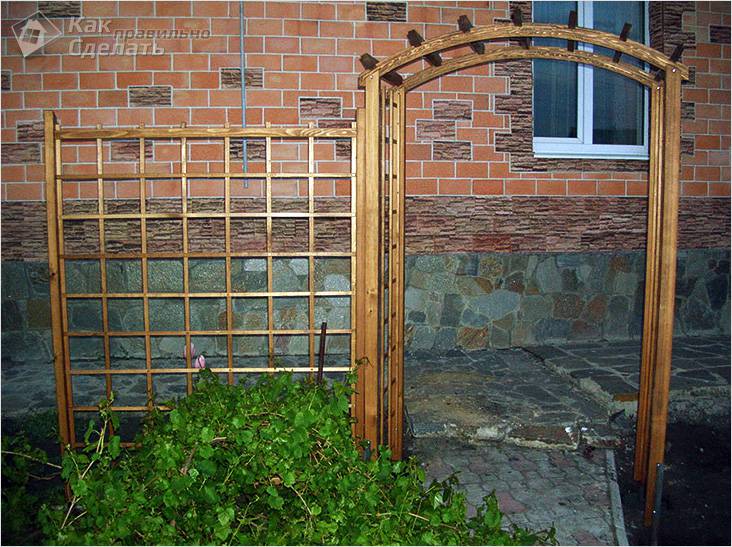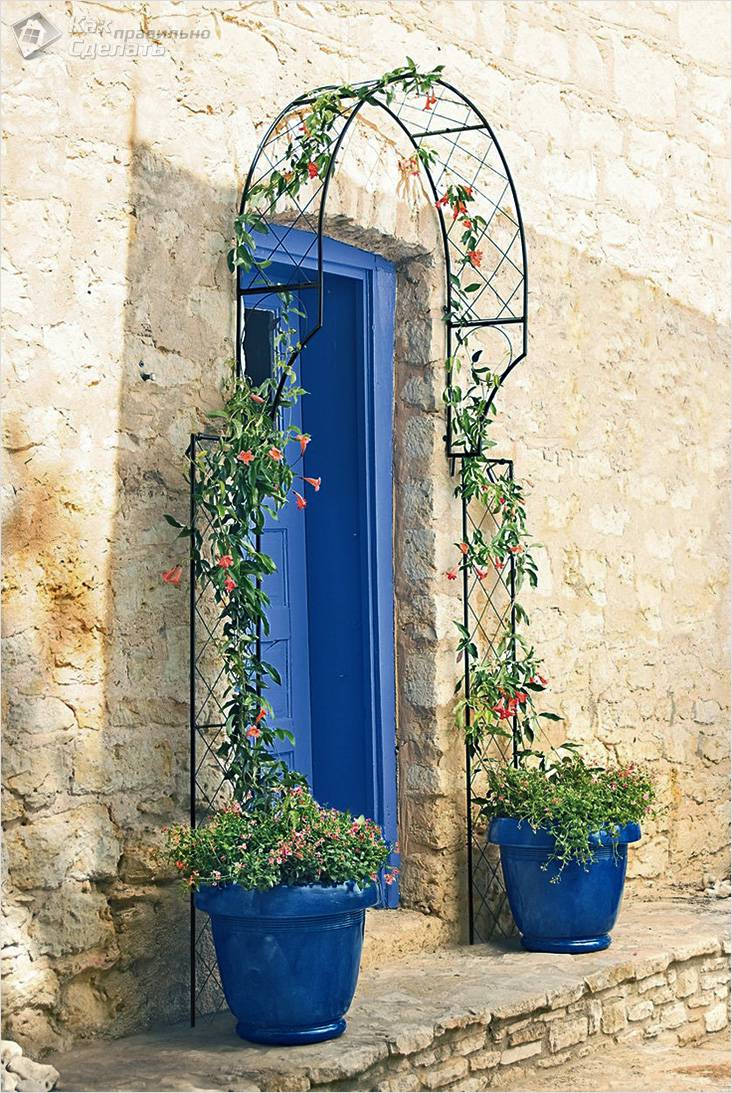Beautiful arches in the garden. Metal garden arch for climbing plants.
Vacation home, big garden- not just a territory for a comfortable family vacation, relaxation, but also a place for the realization of ideas in the field of gardening.
Increasingly, you can see how the territory is decorated with shrubs and fruit trees, but still decorative garden arches give a special decorative effect and sophistication to the site.

The arch can be absolutely any shape and any size, and it all depends on where given element located. The arches basically represent the entrance to another area of the garden, thus dividing the site into a zone for work and a zone for relaxation.

Where to place the arch - it all depends on your imagination, budget. If the goal is to save family budget, but at the same time make the interior unusual, then your option is an ordinary garden arch. Speaking of more expensive option, then you should choose an arch made of wood, stone, forged.

Which arch is better?
If you are aiming to decorate the cottage with curly flowers, you want to zone the space with an arch, then you should not buy any arch that the seller offers you. Equally important is the quality of the material from which the arch is made, and also its durability.


Metal arch (forged)
Such an arch is made of very thin rods, a profile, and strong pipes. Forged arch - the most beautiful option arches, but at the same time the most expensive. The cost of the arch is very high, but at the same time, forging, as well as numerous curls, will attract the attention of guests. The main advantage of a metal arch is that there is no need to prepare a place for further installation.

The disadvantage of the arch is that they need to be painted annually so that the corrosion of the metal does not “eat up”. On average, the cost of such an arch is 500 USD.
![]()
wooden arch
arch from natural wood- Relatively inexpensive design. This type almost all gardeners use at their dacha. The main advantage of such an arch is light and fast production. If there is a hammer, nails, lining available, then you can make that still a masterpiece to the envy of your neighbors. Do-it-yourself garden arch can be painted in any color, can be varnished.


The low cost of such an arch suggests that it does not differ in quality. The main disadvantage is a short service life. Also, the wooden arch must be constantly processed by special means from beetles, tinted with paint, varnish.

The density of the tree is not high, light construction, and therefore, with a strong gust of wind, it is possible that the arch will simply be demolished and broken. The cost of the arch is 100-600 USD.


Arch stone
Such an arch looks solid, solid, and it will stand for hundreds of years without losing color. This arch is easy to care for.

The only drawback of the arch is that not everyone can install it without having certain skills as a mason. In addition, a stone arch located at small house in a tiny allotment.

plastic arch
PVC arch is increasingly used by designers in creating interesting ideas. The cost of plastic is cheap, it does not need to be processed, painted, varnished. In the care of plastic material that does not require investments.

A huge minus of such an arch is that it can not always all year round be on the site. Many manufacturers produce low-quality plastic, and therefore it will become unusable when sub-zero temperature. So, the structure for the winter needs to be disassembled and hidden in the garage.

Another disadvantage is that there is no choice of color. The arch can only be white color. The cost of the arch is approximately 150 USD.

The arch will decorate any cottage. Places of use of the arch:
- At the wall of the house. Arches of garden flowers cover the wall beautifully.
- Entrance to the garden.
- Rest zone.
- Entrance to the veranda.

Naturally, there are many options for the location of the arches. Even if the arch is placed in the center of the summer cottage, letting it beautiful flowers, it will be original and will perfectly complement the garden.

A handmade arch?
Seeing a photo of a garden arch in catalogs, on the Internet, every gardener will say that making it yourself is as easy as shelling pears. And he will be right. The easiest way to make an arch is to take 15 m of reinforcement. 2 pieces are bent into an arc, joined to one another and welded at the junction.

Legs must be welded to the edges of the arcs, and vertical metal sticks of different lengths must be welded onto the arcs. The result of the work done is a staircase, but made in the form of a pretty arch.
Arches and gazebos give a garden or summer cottage unique charm, elegance and individuality. With the help of such structures, you can shade the terrace and create your own oasis of silence and comfort. A gazebo made of natural wood, entwined with flowers and plants, will be an excellent touch for the design of any, even a small area. And the arch for climbing plants already in itself is a work of art and is able to decorate any garden, and even entwined flowering plants, it will become a real pride of the gardener.
Climbing plants for arches
The choice of plants that can be planted near the erected arch so that they, growing up, beautifully braid the structure, is simply huge. But each has its own requirements and characteristics, so the choice of climbing culture should be approached very responsibly. This will help special literature and photos of arches, braided with various types of plants, which will help to present the final version of the appearance of the structure.
We will consider the most popular climbing plants for decorating arches in this article.
The beauty of the rose bud has provided the plant with a strong and unchanging love of gardeners. rose already long time is a classic landscape design and suitable for any garden. And how pleasant it is to walk under an arch dotted with bright, sweet-smelling flowers. This is the most commonly used option for exquisite decoration garden in the likeness of wedding arches, so often seen in the photo.
Huge virtues climbing rose can be called not only the beauty of the bud, but also big choice colors, long flowering, fairly easy care and the ability to survive in fairly dry conditions. The process of planting such a plant is also simple, it will be enough just to plant the purchased bush at the base of the structure and periodically tie the grown stems to the arch, gradually filling the entire plane. And soon the garden decoration will bloom in literally words, pleasing the eyes of the hosts and guests.

plant varieties
Countless varieties of roses have been bred different shades and species, the most interesting of these plants are:
- Ayrshire Splendens - rare, but very beautiful variety, characterized by an unusual smell of myrrh and buds Pink colour various shades from light to dark. The flowers are small, but collected in dense inflorescences, a bush with the help of an arch can reach a height of 6 meters, as can be seen in the photo. The arch, entwined with these roses, looks very sophisticated and solemn, and the intoxicating smell spreads for several meters.
- Cordesa is a variety characterized by large flowers in inflorescences, from snow-white to dark red. The bush blooms thickly and for a long time, delighting the gardener until frost. Another advantage of this variety is easy care, which consists in periodic pruning. Rose Cordesa is not afraid of frost and takes root well in various soils. similar arch will be a real decoration of the garden, which confirms the photo.
- To prepare the plant for winter, it is advisable to cover the rose with a film to protect it from the harmful cold. Because of this, it is not recommended to make the base of the metal structure so that the stems in frost do not suffer from contact with it.
Ivy
It gained its popularity a long time ago and has been used for decoration for several centuries. country houses, effectively braiding the walls and enlivening the landscape with a bright green or reddish color.
Its decorative value lies in the fact that ivy, although it practically does not bloom, is evergreen, decorating the garden even in winter. And although it does not have either luxurious rosebuds or its aroma, but durability, unpretentiousness, frost resistance and ease of care made ivy a desirable decoration for houses, plots and arches. Like all vines, ivy does not require additional care and fertilizer, thanks to its long roots, it independently extracts the amount of minerals, nutrients and water necessary for life.
Thanks to sucker roots, ivy is perfectly attached to the base, with a thick curtain covers ugly fences and walls, protecting them from destruction and protecting them from moisture. Ivy also looks very impressive on arched structures, reliably braiding all the bends of the arch, as you can see in the photo. The only drawback of ivy can be considered its slow growth, so the arch will acquire the desired appearance not in a year or two, but much later.
Grape
Thanks to the beautiful juicy foliage, rapid growth and easy care grapes have become one of the most popular climbing plants. It is enough to plant a sprout near the arch and occasionally cut off the extra shoots with separator scissors - and an excellent garden construction will be created before our eyes without the slightest effort.
Numerous different varieties grapes, decorative types are used to decorate arches, the most popular are:
- Japanese Kuanye grape, it grows on any soil, quickly braids the surface and is famous for its large carved leaves up to 35 cm wide, dark green in summer and purple in autumn days;
- girlish grapes have heart-shaped leaves of red color, with the advent of autumn they acquire a cozy golden hue.
A decorative arch with grapes looks very impressive, and a change in color with the advent of cold weather will allow you to enjoy the onset of autumn.
Clematis
The bright, juicy flowers of this plant are no less attractive than classic rose. Yes, and clematis blooms for a long time, decorating the garden from mid-summer to early winter. Of the many various kinds you can choose a plant for every taste and color (photo).
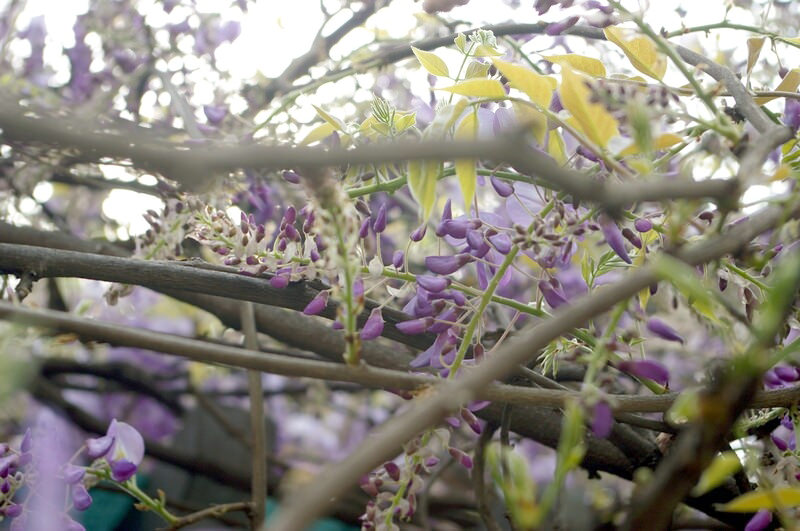
plant care
The most common varieties are:
- Patens - this plant is able to climb the support almost 5 meters in height, decorating the arch with beautiful large buds up to 17 cm in diameter, the flowers themselves in the bush can differ in color, often several shades are beautifully mixed even in one flower.
- Jacqueman - distinguished by spectacular colors of blue, purple or purple hues, reaching 20 cm in diameter, the bush blooms for almost 2 months - from the beginning of July to the end of August, but the thin branches of this variety need a strong arched base.
Clematis - very tender garden culture, to maintain beauty requires constant moderate watering and fertilizer, grows only in fertile soil. Also, clematis is afraid of frost, and in order to protect the bush from the cold, you need to cut the bush at a height of 20 cm from the ground in the fall and cover it with foliage or peat.
Despite the whimsical care, clematis is worth the effort, which is confirmed by photos of arches of incredible beauty.
Campsis
A tree-like plant from the genus vines, characterized by unpretentiousness and active growth- a small sprout after 2 years turns into a huge bush 5 meters high. This decorative culture adheres well to various supporting structures, including the arches. Hanging from the base of the arch, lush green branches bloom in July with orange or yellow inflorescences of bluebell buds, and this beauty will remain until the first frost.
Hop
This horticultural culture is unpretentious, can grow on any soil, taking deep roots and independently extracting the necessary nutrients. Hops can decorate the garden for up to 30 years in a row, requiring little or no maintenance. In addition, the plant grows quite quickly, stretching to a length of up to 11 meters during the warm period, which allows you to completely braid the arch in just a year or two.
Decorative composition with hops will great decoration suburban area from early spring to late autumn. But this plant has one more advantage - in the autumn months, hops are decorated with yellow cones, which have long been used by the people to treat nervous diseases, because their decoction perfectly soothes. The pads filled with hop cones help to get rid of insomnia. A small bag of hops, suspended near the baby's bed, will relieve his irritability and nervousness, help him sleep soundly and calmly. The decoction also has diuretic and analgesic properties. Hops are not only a spectacular and unpretentious garden crop, but also a constant natural first aid kit at hand.
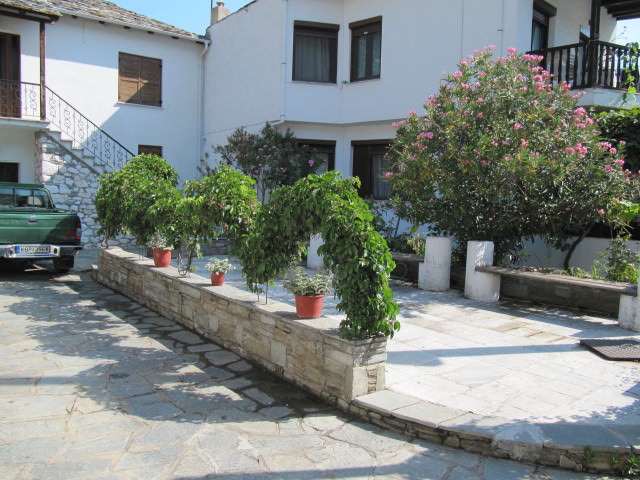
climbing arches
Consider the main varieties of hops that can be used to decorate a personal plot:
- Japanese hop - grows much slower, but attracts with variegated carved leaves, this annual plant, which is planted with seeds near arches and arbors, and in just a year or two the plant completely wraps around the structure, as seen in the photo;
- common hop - common almost everywhere, very undemanding to care and conditions.
But the hop also has one unpleasant feature - it is able to grow, clogging neighboring crops with its roots, so you need to constantly monitor that it does not leave the territory allocated to it, cutting off extra branches and roots.
To garden plot was unique and attractive, it must have an exotic, unique element that can delight any aesthete. The greatest number of rave reviews is invariably caused by various climbing cultures, which any gardener can rightly be proud of. Creepers and various climbing cultures will perfectly cover ugly sections of a fence or building, create cozy atmosphere in the gazebo and give the arched path a fabulous beauty.
The growth rate of such plants is also very pleasing, because in order for the tree to acquire the desired size, many years must pass, and climbing plants are able to create a flowering arch, if not for the first, then certainly for the second year after planting. At the same time, such plants in just one season can completely cover graceful arches with their foliage and delight the owners of the house and not only with their beautiful appearance.
From the existing variety of climbing crops, you can always choose to your taste and color, it can be both floral and deciduous plants. And huge multi-colored, pungent-smelling roses and clematis, and leafy hops, ivy and grapes can, at the request of the gardener, create unique design plot, attracting and pleasing the eyes of the owners and guests. From the foregoing, we can conclude that varieties and varieties of climbing plants that can decorate household plot and arches in the garden great amount, it's up to you to choose. It all depends on the preferences and wishes of the summer resident, who decided to plant one or another type of climbing plants in his summer cottage, which can completely change appearance garden and give it sophistication and sophistication. Such a garden will please the eye with its beautiful color and graceful plants.
Growing climbing flowers is impossible without providing them with reliable support. In this capacity, any supports are used: poles, fences, stretched threads, etc. However, the most spectacular sight can be obtained by forming a tandem of curly with special architectural elements. One of the most popular of these structures is the arch - an arched building on two supports. Despite the highest decorative qualities, its design is very simple, so the arch for flowers in the country can be made by hand. Consider 3 options for its manufacture from various materials.
A simple model of an arch with a height of 2130 mm and a width of 1830 mm is created from two reinforcing sections bent into arcs, interconnected by metal rings. The arch for flowers is made by hand without the use of welding, it is used to connect parts thin wire.
The metal arch looks like a light, weightless structure entwined with greenery and flowers.
The distance between the arched arched sections is 31-32 cm. To keep them in place, they are dug into the ground at least 40-45 cm. A distance of 15 cm is observed between the unifying cross-beam rings (d \u003d 30 cm).

Schematic representation of a metal arch
List of materials for the manufacture of a metal arch:
- fittings (rod) d = 10 mm, length 6 m - 2 pcs.;
- fittings (rod) d = 6 mm, length 0.94 m - 9 pcs.;
- soft wire;
- primer, enamel for painting;
- pins for the template - reinforcement d = 10 mm, length 0.25 m - 10 pcs.;
- rope L=0.9 m.
Step-by-step manufacturing scheme:
1. First of all, you need to bend pieces of reinforcement d = 10 mm to get an arched opening. To do this, you can use a simple template of pins 0.25 m long, driven into the ground along the calculated contour of the arch.

Cut the rebar into pins with a hacksaw
The contour is drawn directly on the ground as follows: a rod is driven into the ground, a rope L = 0.9 m is tied to it and, taking the free end in hand, a semicircle is drawn with paint or chalk. After that, starting from top point semicircle, drive pins into the ground.

Drawing a semicircle with a rod, rope and paint
The resulting template is very easy to use. In order to give the arch an arcuate shape, the reinforcement d = 10 mm is bent around the driven pins. The bend will be smoother if a strong, but flexible material. A strip of siding, a chipboard strip, etc. will do.

Rebar bending is a laborious process, which is easier to cope with together with an assistant
2. In this arch model, metal rings are used to connect the reinforcing sections. They are made from thinner than the main sections, fittings d = 6 mm.
9 pieces of 94 cm are cut from a bunch of reinforcement and rings are formed from them using a pipe bender. In the event that you do not have this tool, the design of the arch can be simplified and, instead of rings, connect the arc-shaped sections with straight rods. It will be easier to look like this arch original version, but it will also be quite functional.

Forming rings from rebar using a pipe bender
3. The bent main sections of the arch are installed in the ground, deepening the reinforcement by 40-45 cm.

4. At a distance of 61 cm from the bottom of the arch, metal rings are tied with soft wire, keeping a distance of 15-20 cm between them. They will allow you to connect the arcuate sections together and fix the shape of the arch.
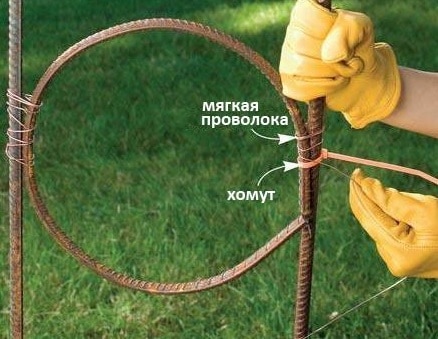
Fastening rings to the metal sections of the arch
5. To protect the arch from corrosion, all metal parts of the product are coated with a primer, and then with a layer oil paint.
Option #2. Wooden arch from a bar
A traditional wooden arch made of timber is the simplest and most inexpensive structure that fits into the design of any garden. This garden arch for flowers, 2.2 m high, consists of two vertical frames, two inclined and one horizontal parts.

An easy-to-make wooden arch will help divide the garden space into functional areas
Materials needed for construction:
- timber 40x50 mm, length 2 m - 4 pcs.;
- timber 40x50 mm, length 0.35 m - 4 pcs.;
- timber 40x50 mm, length 0.65 m - 2 pcs.;
- wooden planks 35x20 mm, length 0.65 m - 24 pieces;
- wooden planks 35x20 mm, length 2 m - 2 pcs.;
- metal corner, length 0.25 m - 4 pcs.;
- screws or nails;
- primer, paint.
Wooden arch construction plan:
1. Two vertical frames are knocked together. Each frame consists of two vertical supports 2 m each, two crossbars 0.65 m each and one plank in the middle, 2 m long.

2. Collect the sidewall of the arch. Planks 35x20 mm 0.65 m long are stuffed onto the frame in increments of 0.2 m. The edges of the planks are cut at 45 °, irregularities are polished sandpaper or grinder.
3. Metal corners are attached to the vertical posts. Subsequently, when they are installed in the ground, they will play the role of a foundation and will be able to hold the structure in a given position.
4. Cut out the bars for the top of the arch. Inclined bars 0.35 cm long - 4 pcs., Upper horizontal bars 0.65 m long - 2 pcs. They are fastened together with self-tapping screws.
5. top arches are connected to the sidewalls.

The arch is completely assembled on the ground, and then it is lifted and placed vertically on permanent place
6. Dig holes at the installation site of the arch supports. Metal corners are fixed in the ground, setting the arch in level. In order to wooden structure lasted longer, you can substitute stones under the supports.

7. On wooden surfaces a primer is applied, then a layer of varnish or paint.
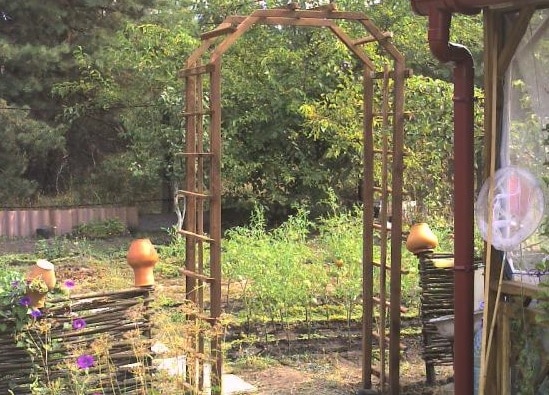
A layer of varnish protects the wood from corrosion and increases decorative properties arches
Option #3. Arch with gabion base
A wooden arch will become a convenient support for climbing flowers, the side parts and the rounded top of which are formed from galvanized mesh. Another unexpected detail of this design is the foundation of two massive gabions. They firmly hold the arch supports, eliminating the need to pour concrete foundation or dig the posts into the ground.
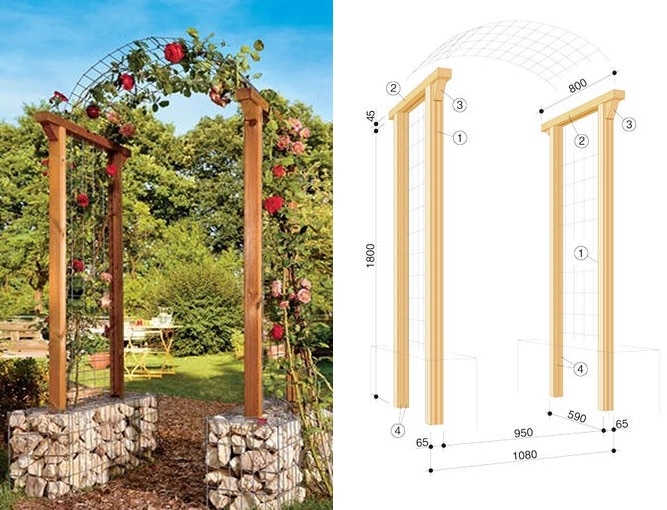
Unusual arched design - a combination of beams, mesh and gabions
Materials used:
- beam 65x45 mm, length 1800 mm (4 pcs.) - vertical supports;
- timber 65x45 mm, length 800 mm (2 pcs.) - transverse beams;
- timber 21x10 mm, length 1380 mm (8 pcs.) - slats for creating grooves;
- sheets of galvanized mesh, width 500 mm, length 1800 mm (2 pcs.) - for the sides and top of the arch;
- metal grid double torsion - for the manufacture of gabions;
- galvanized wire;
- screws.
Stages of production of an arch on gabions:
1. Two gabions with dimensions of 100x50x50 cm are made from nets. Each gabion consists of three boxes: two for the base (they will be installed wooden poles arches), one - uniting, smaller in size. Gabion parts are connected with strong galvanized wire.

The gabion box is made of a strong mesh, ideally - from a special, so-called "gabion"
2. On each transverse beam, a cutter makes through cuts 4 mm wide, 500 mm long. In the future, a trellis mesh will be inserted into this groove.

Cutting a through groove along the cross bar
3. Vertical racks are fixed on the sides cross beams with screws.

Screw connection of crossbars and uprights arches
4. Triangular brackets are attached to the uprights and crossbars - to stiffen the structure.

Mounting the bracket to the crossbar and support increases the strength of the structure
5. On the vertical supports, the groove for attaching the mesh is formed by two wooden slats. They are fixed with a screw connection at the top and bottom of the support bars.
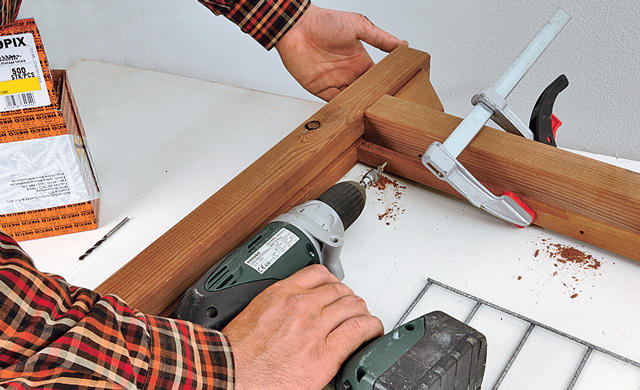
Two rails are fixed along each support at a small distance from each other (3-4 mm). This allows you to create a groove for fixing the mesh on the side of the supports.
6. The mesh is inserted into the grooves formed by the rails in the support posts and pulled out through the slot in the horizontal cross member.

The mesh is installed in the grooves on the crossbar and side supports
7. Install the support posts of the arch in the gabion boxes.
8. Gabions are filled with stones: basalt, granite, limestone, glass blocks, etc. At the same time, they strive to fix the support posts as tightly as possible so that they cannot move during operation.

9. To obtain a rounded top of the arch, the mesh sheets are bent towards each other and tied in the middle with steel wire.

When the arch is ready, it does not matter if it is metal or wooden, climbing flowers are planted near it. Therefore, do not worry about minor defects in the construction! Massive lashes of weaving roses, clematis, annual morning glory or sweet pea hide all design errors, often made in the process of independent production.
Each owner who has an inherent desire to equip it, decorate it, create the opportunity to work pleasantly and fully relax. This is achieved by the construction of the necessary structures, the cultivation of a vegetable garden, and planting. But as decoration, arched structures are used, which are distinguished by their decorative effect. So, do-it-yourself garden arches - types, methods of creation and design.
It is possible to distribute arches into groups according to several criteria. According to the material used for construction, arches are made of wood, metal, plastic, stone, and even mixed (from several materials at the same time).
Supporting forms for climbing plants are made in the form of curvilinear structures, trellises, pergolas, and other complicated forms.
The location of such structures on the site is isolated, in groups, in the form of walls from trellises, in the form of gazebos.
Installation rules

Everything has already been done for you - a house has been built, a plot has been divided into zones, a garden has been planted. It remains only to install the elements decorating the yard.
A variant of placement in the form of an entrance element to the territory is proposed. Install an arch above the gate, creating a kind of invitation to visit. The same method is applicable for installing an arched element in front of the garden area, dividing the yard into zones. In this case, a small fence around the perimeter would be appropriate.
From several arches with horizontally executed connections, a pergola is arranged. With its help, it will perfectly decorate any garden path leading you to the recreation area.
On the small areas, where it is not possible to arrange arched structures and especially pergolas, use trellises. These lattices made of wooden slats will not take up much space, they will become an excellent support for those planted for beauty. Their location is possible even along the walls of buildings.
The structure of several trellises, located around the bench, will help you create a shade in sunny weather, where you will spend pleasant hours of relaxation. With the device of a primitive ceiling, this place easily turns into a gazebo made of plants. To do this, it is enough to stretch the wire or lay poles so that the plants can wrap their sprouts around them, forming a ceiling.
Items listed are available from ready-made or make your own. For this, metal or wooden material, plastic.
Do-it-yourself arch making

With some skill and availability simple tools, arches or a pergola for a garden is not difficult to make.
To install a simple wooden pergola, prepare wooden posts with a cross section of 10 by 10 cm and a height of at least two meters. They will act as supports placed vertically. support poles are connected by transverse rails, to which crossbars from edged boards are subsequently attached.
Pits are prepared in the ground for the installation of posts. To make the structure stable, the pillars are recommended to be concreted. Their installation must be carried out strictly vertically, for which we recommend using the building level. As an addition, it is allowed to stretch a fishing line or twine between the slats, arrange a crate of thin slats. To prolong their service life, we recommend processing wooden elements antiseptic preparations.
Installed arched structures or pergolas are decorated to your taste, painted in any color.
Suitable climbing plant species
 curly nasturtium, ivy or hops and many others.
curly nasturtium, ivy or hops and many others.
It is allowed to use plants with beautiful inflorescences, abundant greenery and decorative fruits as decorations. Curly lashes, reaching a height of several meters, with the help of arches and pergolas, can be given the necessary forms, creating unusual compositions.
Experts advise choosing plants for decorating arches that are most suitable for your climatic conditions. It is likely that many of them will have to arrange shelters for the winter.
There are no difficulties in decorating arches with plants. Plants planted on the sides of the structure must be fixed to its walls. As they grow, the upper sprouts should be bent so that in the process of development they form a vault resembling the shape of an arch. At the same time, it is important to do everything in a timely manner. When bent prematurely upwards, they will begin to actively grow side shoots. And if you are late, the hardened branches will not be able to tightly wrap around the arched elements. And yes, they can be easily broken.

When making an arch, which should become a reliable frame for plants, choose the right material. It should be taken into account that it must create not only a decent appearance, but also be stable and durable. Such an example is metal structures that are not afraid of exposure to precipitation and temperature changes. But on frosty days, metal elements can cause damage to plants of late varieties.

Structures made of wooden material tolerate temperature changes worse, have damage from pests. Such facilities are suitable for areas with moderate climate conditions. And even in this case, for arches, the wooden material should be from strong woods.

Structures made of plastic material also endure the wet season badly. Often they are made collapsible, so on winter season it is possible to dismantle the elements and hide until spring.
The forms of arched structures are varied. There are options for two roof slopes or rectangular. Each of them can become wonderful element to decorate the area.
All gardeners know that it is almost impossible to grow climbing flowers without support. For this purpose, any props are chosen: stretched ropes, fences, posts, etc. But the use of such materials will not be enough to create a spectacular spectacle. To make your garden beautiful and fascinating look, use special architectural elements.
The most popular of them is an arched building on two supports or an arch. Despite the fact that she has the highest decorative qualities, the design itself is quite primitive. Therefore, it is within the power of everyone to build it. One has only to find out what types there are, how they differ and what is necessary for work. This article is about how to make a garden arch with your own hands from various materials (metal, wood, plastic pipes).
Selecting the type of structure

Today there is a large assortment various garden arches. All of them differ in their shape and material. Such designs can be:
- metal;
- wooden;
- plastic;
- trellis.
All of them are similar in purpose. There are special arches for grapes, decorative arches for climbing plants, as well as arches for a recreation area. There are many destinations - the choice is yours.
Making a metal structure
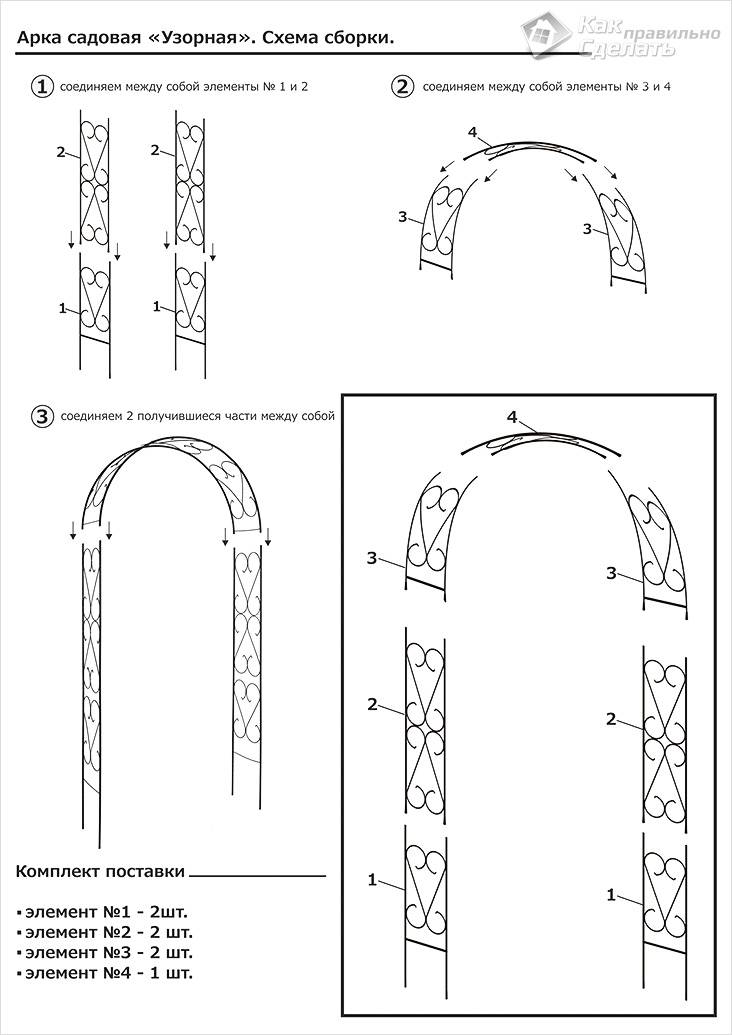
The classic and most popular is the metal arch. let's consider simple model, having a height of 2130 mm and a width of 1830 mm. It is made from two bars of reinforcement, which will be bent into arcs. Metal rings will connect them. A feature of this design is that it can be performed without using welding machine, all parts will be connected with a thin wire.
The distance between the arched sections is 31–32 cm. To keep the arch in place, it must be dug into the ground at least 40–50 cm. The connecting rings-crossbars should be 30 cm in diameter, and the distance between them should be 15 cm.
List of required materials

To perform the work, first prepare the following materials:
- reinforcement bar, diameter (hereinafter in the text this icon will be used - Ø) 10 mm, 6 m long - 2 pcs.;
- reinforcement bar (Ø mm), 0.94 m long - 9 pcs.;
- strong wire, soft;
- enamel for painting and primer;
- fittings (Ø 10 mm), 0.25 m long, like pins for a template - 10 pcs.;
- a rope 1 m long.
Step-by-step instruction
First you need to bend the reinforcement bars d = 10 mm so as to get the perfect arched opening. To do this, use a simple rebar pin template. Insert pins 0.25 m long into the ground so as to obtain the calculated contour of the arch.

The outline must be drawn directly on the ground. To complete a perfect circle, drive a rod into the ground and tie a rope to it. Take the free end in your hand and draw a semicircle with chalk or paint. Then drive the pins into the ground starting from the highest point of the semicircle. You now have a template that is easy to use. It remains to bend the reinforcement bars, giving them a semicircular shape. It will be difficult to do it yourself, so ask a friend or neighbor to help you. Directed efforts are needed on both sides to get an arched opening of an ideal shape.
Be especially careful when performing this step. The rebar could come off and cause injury to you or your helper.
For this arch model, metal rings will serve as a connection for the reinforcing sections. They are made of thin reinforcement Ø 6 mm. To do this, you need to cut 9 pieces of reinforcing bars 94 cm long. Using a pipe bender, you need to form rings from them.

If you do not have this tool or simply do not want to complicate the work, the design can be simplified: use straight rods instead of rings. Such an arch will look simpler, but in terms of functionality it will not be inferior to the original version.
The finished main sections must be installed in the ground. To do this, the ends of the reinforcement should be deepened inward by 40–50 cm. Measure 40 cm from the end of the reinforcement that will be deepened into the ground and wrap this place with electrical tape. Do this with all 4 ends. So, you will know when to stop.
We connect the main frames with rings. From the bottom of the arch, measure 61 cm and secure the first ring. To hold it, you can use a construction clamp. Now wind the connections flexible wire so that the ring is securely fixed and holds the structure. We fix the following rings according to the same method, maintaining a distance of 15–20 cm.
After finishing work, coat all metal parts with a primer. After it dries, apply a layer of oil paint. That's it, your arch is ready to use.
Other types of arches

Other arches are made according to exactly the same principle. For instance, wooden arches made from timber. This is a simple and inexpensive construction. Thanks to natural material, it fits well into the design of any garden. To build such an arch, you need 2 vertical frames, 2 inclined and 1 horizontal part. All this is connected with wooden crossbars using nails. Finished construction dug into the ground, primed and varnished.
Plastic arches are a structure made of plastic pipes. Such arches are considered the easiest to manufacture, they are easy to assemble and disassemble. If you want to make yourself a structure of this type, then you need to consider that plastic is not able to transfer low temperatures, therefore, such structures are often made collapsible. Decorate such an arch with annual plants.
Forged arched structures and pergolas are very popular. Such arches look very elegant and will decorate your country cottage area all year round. Moreover, they are durable and resistant to different weather conditions. To make your stay in the garden more comfortable, you can make an arch with a bench. In this case, you can enjoy the beauty of your garden while sitting under the arch. As you can see, there are a lot of options, you just need to make an effort and imagination, then your garden will look like a real embodiment of your ideas.
Arch with railing
